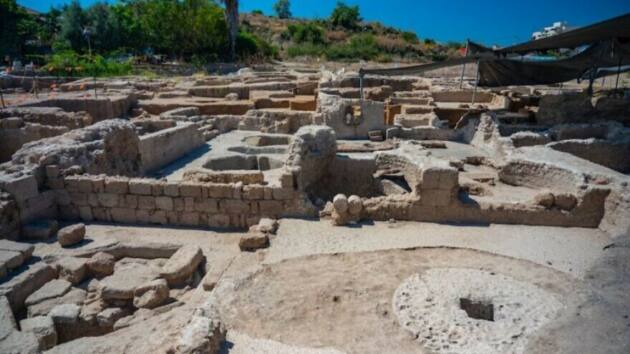Jesus turned water into wine and just a few centuries later, the early church in Israel was producing the drink on a massive industrial scale.
Israel archaeologists have uncovered a gargantuan winemaking factory from the Byzantine era that is considered to be the largest known complex of its kind from that time period in the entire world.
As part of preliminary work to build a new neighborhood, archeologists found the 1,500-year-old industrial complex, which includes five winepresses, warehouses to age and market the wine, kilns for firing the clay jars storing the wines and tens of thousands of earthenware jars, both intact and fragmented.
Yavne excavation directors, from left, Dr. Elie Hadad, Liat Nadav-Ziv and Dr. Jon Seligman, together with some of their finds. Credit: Yaniv Berman/Israel Antiquities Authority.
“This area was one of the major centers of winegrowing and wine production for international trade,” said John Seligman, Ph.D., Israel Antiquities Authority archaeologist and excavation director.
In use during the fifth and sixth centuries, the industrial facility would have produced and marketed more than two million quarts of wine each year. Known as Gazan wine, it was named for the port from which it was exported to the Mediterranean basin.
“This was a white wine, a wine of high quality,” Seligman said. “It was certainly a prestigious wine. This was a wine that we know was presented during the coronations of Byzantine kings. Justin the Second had wine from this region presented at his table during his coronation.”
According to Jewish News Service, “Drinking wine was common in the Byzantine period, both for adults and children. This was because water was often either unsanitary or unpalatable, and wine was used as a ‘concentrate’ to improve its flavor, or as a replacement drink.”
The authority began the excavation here in 2019. It’s one of the largest excavations it has ever carried out. “This is what is revolutionary in the way that we have not one single winepress somewhere in the field, but we have five winepresses of huge size, for mass production of wine all together in a cluster,” he said.
Seligman explained grapes would be tread by foot and the juice would flow through a channel into a dumping area and filtration pit where the skins would be separated from the juice and then flow into vats for three or four days of fermentation. Then the wine would be collected and put in jars in the warehouses.
Christians, Jews and Samaritans would have been living in the area at the time. The grapes would have been grown in the surrounding vineyards, and the site even had kilns for making jars. According to Seligman, wine often was the drink of choice in those days because of the poor quality of the drinking water.
Excavations at the site are scheduled to continue for two years. Afterwards, the city plans to build a bridge over it to make it accessible for tourists.
–Alan Goforth | Metro Voice
